Runway lights are the unsung heroes of aviation safety, guiding pilots through darkness, fog, rain, and low-visibility conditions to ensure safe takeoffs and landings. Without runway lights, night operations and poor-weather flights would be nearly impossible, grinding global air travel to a halt. In this exhaustive guide, we’ll explore every aspect of runway lights: their types, functions, technology, regulations, maintenance, and why they’re indispensable for modern aviation. Whether you’re an airport operator, pilot, aviation student, or industry supplier, this handbook will equip you with the knowledge to understand, select, and maintain runway lights that meet the highest safety standards.
What Are Runway Lights?
Runway lights are specialized lighting systems installed along and around runways to define their boundaries, indicate critical zones (like thresholds and centerlines), and provide visual cues to pilots during takeoff, landing, and taxiing. Unlike general outdoor lighting, runway lights are engineered to withstand extreme weather (temperatures from -40°F to 120°F), vibration from aircraft, and chemical exposure (from de-icing fluids), all while delivering consistent performance.
The primary goal of runway lights is to enhance situational awareness for pilots. In low-visibility conditions—such as night, fog, or heavy rain—runway lights create a visual “path” that helps pilots align with the runway, judge distance, and avoid obstacles. They also communicate critical information, like runway length, direction, and whether a runway is active (in use) or closed.
Runway lights are not one-size-fits-all. They come in various types, each serving a specific purpose, from marking the edges of the runway to warning pilots of approaching thresholds. Together, these lights form a coordinated system that works with other aviation technologies (like instrument landing systems and runway visual range sensors) to create a comprehensive safety net.
Types of Runway Lights: A Detailed Breakdown
Runway lights are categorized by their location, function, and color, each designed to address specific challenges in aviation operations. Let’s explore the key types:
Runway Edge Lights
Runway edge lights are the most basic and essential type of runway lights, marking the lateral boundaries of the runway. They are installed along both sides of the runway, spaced 200–300 feet apart (depending on runway length), and extend from the threshold to the end of the runway.
- Color: Typically white, but transition to yellow for the last 2,000 feet (or half the runway length, whichever is shorter) to alert pilots they’re approaching the runway end.
- Intensity: Adjustable (from 10 to 100 candelas) to avoid dazzling pilots in low light or being too dim in bright conditions. Modern systems allow remote adjustment via airport control towers.
- Technology: LED runway edge lights are now standard, replacing incandescent bulbs due to their longer lifespan (50,000+ hours vs. 1,000 hours for incandescents) and lower energy use.
- Regulatory Note: ICAO (International Civil Aviation Organization) requires runway edge lights for all runways used at night or in low-visibility conditions.
Runway Centerline Lights
Runway centerline lights run along the longitudinal center of the runway, helping pilots maintain alignment during takeoff and landing—critical for preventing runway excursions (when an aircraft veers off the runway).
- Spacing: Installed every 50 feet, creating a continuous line that guides pilots down the runway’s center.
- Color Pattern: White for most of the runway, but the last 1,000 feet use alternating white and red lights, with the final 100 feet being all red. This warns pilots they’re nearing the runway end.
- Visibility: Designed to be visible through water, snow, and fog. LED versions use focused optics to minimize light scatter, ensuring visibility even in dense conditions.
- Application: Mandatory for runways longer than 3,000 feet and for all runways certified for instrument flight rules (IFR) operations.
Threshold Lights
Threshold lights mark the start of the runway (the threshold), where landing aircraft begin their touchdown. They help pilots identify the runway’s starting point, especially in darkness or fog.
- Position: Installed along the threshold, perpendicular to the runway edge lights.
- Color: Green, distinguishing them from other runway lights and signaling the “entry point” for landings.
- Configuration: Often paired with threshold markings (painted lines), but threshold lights are more visible in low-visibility conditions.
- Variations: Some airports use “threshold bar lights”—a row of 6–12 green lights placed across the threshold—to enhance visibility.
Runway End Lights
Runway end lights are installed at the opposite end of the runway from the threshold, marking the runway’s end to prevent overshoots.
- Color: Red, a universal warning color, indicating pilots should not proceed beyond this point.
- Design: Often collimated (focused) to be visible from a distance, even in bright daylight.
- Integration: Work with runway end markings (painted chevrons) to reinforce the warning.
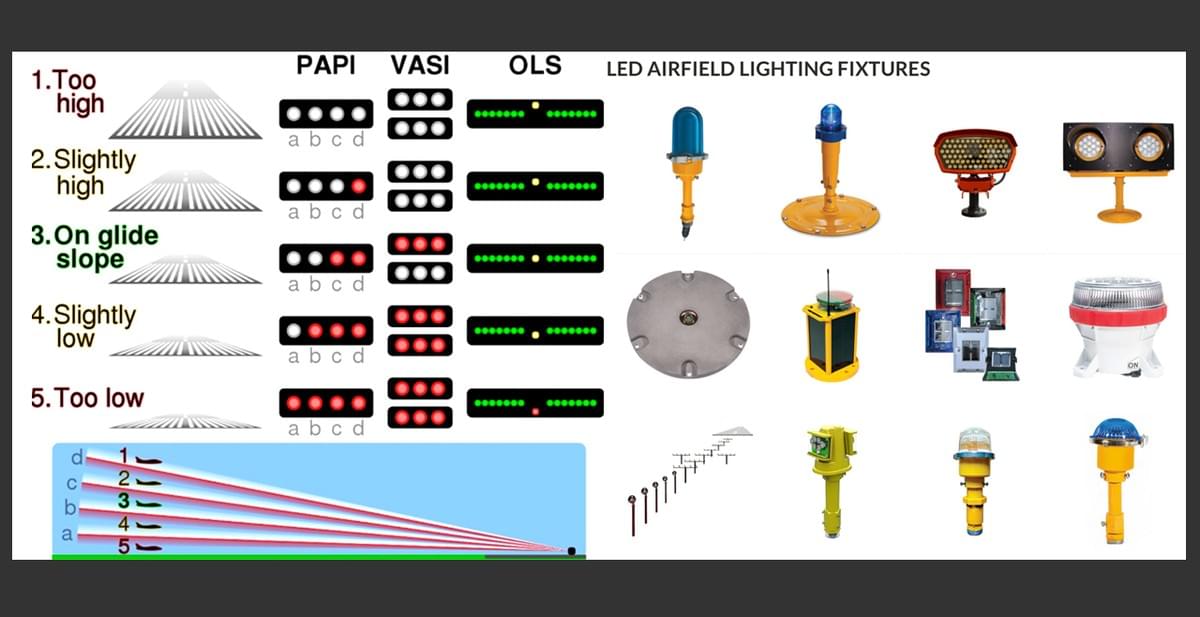
Touchdown Zone Lights (TDZL)
Touchdown zone lights help pilots identify the optimal area for landing (the first 3,000 feet of the runway) and judge their height above the runway.
- Configuration: Two rows of white lights, each extending 3,000 feet from the threshold, offset 10 feet from the runway centerline.
- Function: Create a “target area” for landing, especially useful in low-visibility conditions where depth perception is poor.
- Technology: High-intensity LEDs with directional lenses, ensuring visibility from the final approach path (3–5 miles from the runway).
- Regulatory Requirement: Required for runways certified for Category II or III instrument landings (low-visibility operations).
Taxiway Lead-Off and Lead-On Lights
While not strictly runway lights, these lights connect taxiways to runways, guiding aircraft from taxiways onto runways (lead-on) and from runways to taxiways (lead-off).
- Color: Alternating green and yellow, distinguishing them from runway and taxiway lights.
- Path Guidance: Form a continuous line from the taxiway to the runway centerline, reducing the risk of wrong-turns.
- Integration: Sync with runway status lights (RSLs) to prevent entry onto active runways.
Runway Status Lights (RSLs)
Runway status lights are a safety enhancement system that uses red and white lights to warn pilots and vehicle operators of potential conflicts on runways.
- Types:
- Runway Entrance Lights (RELs): Red lights at taxiway entrances to runways, activated when the runway is occupied.
- Takeoff Hold Lights (THLs): Red lights across the runway centerline, preventing takeoffs if another aircraft is landing.
- Automation: Linked to radar and aircraft tracking systems, activating within seconds of a detected conflict—faster than human reaction times.
- Effectiveness: Studies show RSLs reduce runway incursions by up to 50%, making them a critical addition to modern runway lights systems.
Approach Lighting Systems (ALS)
Approach lighting systems are not runway lights per se but are closely integrated with them, extending from the runway threshold into the approach path to guide aircraft during final approach.
- Configuration: Varies by airport, but common types include:
- Simple Approach Lighting System (SALS): A row of white lights extending 1,400 feet from the threshold.
- Medium Intensity Approach Lighting System with Runway Alignment Indicator Lights (MALSR): Includes a central line of lights plus “alignment lights” that form a V-shape, enhancing runway alignment.
- Color: White, with red lights marking the last 100 feet before the threshold.
- Role: Bridges the gap between en-route navigation and runway lights, helping pilots transition from instrument guidance to visual reference.
Technology Behind Modern Runway Lights
Runway lights have evolved dramatically from the incandescent bulbs of the 20th century to today’s advanced LED systems. Let’s explore the technology driving modern runway lights:
LED vs. Incandescent Runway Lights
The shift from incandescent to LED runway lights is one of the most significant advancements in aviation lighting:
- Lifespan: LED runway lights last 50,000–100,000 hours, compared to 1,000–2,000 hours for incandescents. This reduces maintenance costs and downtime—critical for busy airports.
- Energy Efficiency: LEDs use 70–80% less energy than incandescents, lowering airports’ electricity bills. For a large airport with 10,000 runway lights, this can save $500,000+ annually.
- Durability: LEDs are solid-state (no filaments), making them resistant to vibration and shock—essential for withstanding aircraft takeoffs and landings.
- Instant On/Off: LEDs light up immediately, unlike incandescents, which take time to warm up. This is crucial for runway status lights, which must activate instantly during emergencies.
- Color Consistency: LEDs produce precise colors (green, red, white) without fading, ensuring compliance with regulatory standards.
Dimming and Control Systems
Modern runway lights feature advanced dimming systems that adjust intensity based on conditions:
- Photocells: Automatically dim runway lights during daylight and brighten them at night, reducing glare and energy use.
- Remote Control: Airport operators in control towers can adjust intensity manually via software, responding to changing weather (e.g., brightening lights during fog).
- Pilot-Controlled Lighting (PCL): Smaller airports use PCL, allowing pilots to activate and dim runway lights via radio signals (e.g., keying the microphone 3 times for full brightness).
Weather Resistance
Runway lights must operate in extreme conditions, so their design includes:
- Sealing: IP68-rated enclosures (waterproof and dustproof) prevent damage from rain, snow, and de-icing fluids.
- Heating Elements: Some runway lights (especially in cold climates) have built-in heaters to melt snow and ice, ensuring visibility.
- Corrosion Resistance: Aluminum or stainless-steel housings resist rust from saltwater (coastal airports) and chemicals.
Smart Runway Lights
Emerging technologies are making runway lights “smart,” with features like:
- Sensor Integration: Lights with built-in sensors monitor temperature, humidity, and light output, sending data to maintenance teams for predictive repairs.
- Wireless Communication: Mesh networks allow runway lights to communicate with each other, enabling synchronized dimming and rapid fault detection.
- Energy Harvesting: Experimental systems use solar panels or vibration from aircraft to power LED runway lights, reducing reliance on grid electricity.
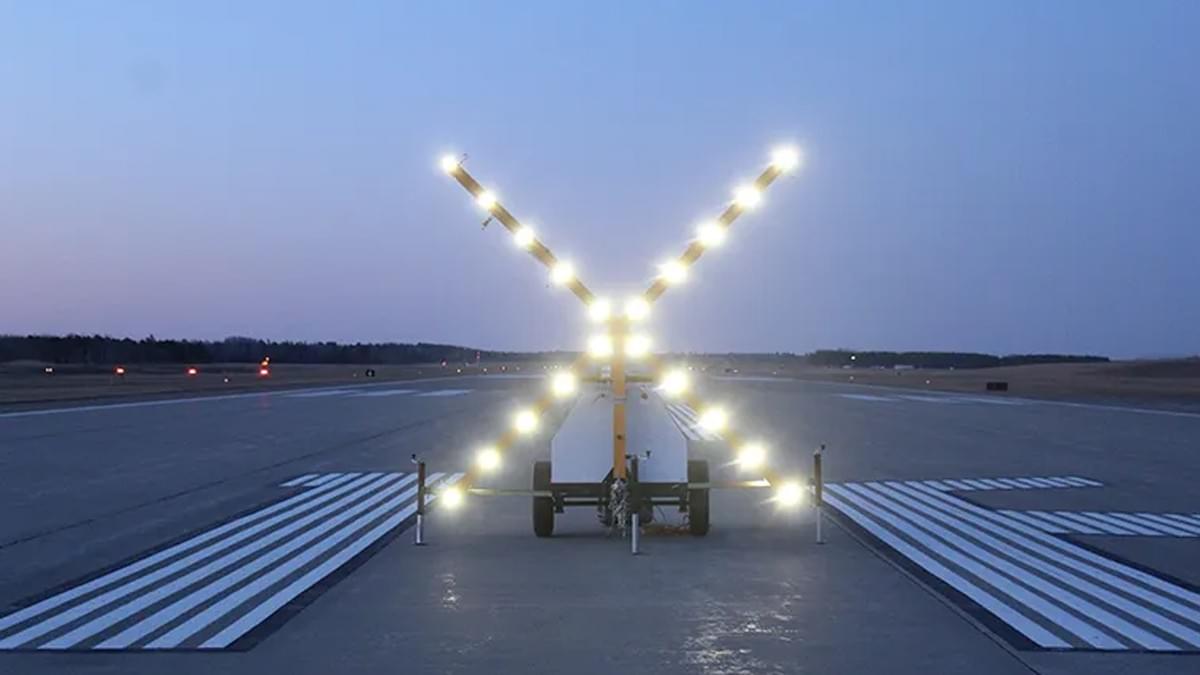
Regulatory Standards for Runway Lights
Runway lights are governed by strict global standards to ensure consistency and safety. Key regulatory bodies include:
ICAO Standards (International Civil Aviation Organization)
ICAO’s Annex 14 (Aerodromes) sets global requirements for runway lights:
- Color Specifications: Mandates precise wavelengths for green (threshold lights), red (runway end lights), and white (edge/centerline lights).
- Intensity Ranges: Requires runway lights to be adjustable between 10 and 100 candelas, with minimum visibility distances (e.g., 3 miles for approach lights).
- Spacing and Placement: Dictates distances between edge lights (maximum 300 feet) and centerline lights (50 feet) to ensure uniform guidance.
- Reliability: Requires backup power systems (batteries or generators) to keep runway lights operational during power outages for at least 90 minutes.
FAA Regulations (Federal Aviation Administration, U.S.)
The FAA’s Advisory Circular AC 150/5345-46B expands on ICAO standards for U.S. airports:
- LED Certification: Requires LED runway lights to meet performance standards (e.g., color stability, dimming range) before approval.
- Maintenance Schedules: Mandates regular inspections (daily visual checks, monthly intensity tests) to ensure runway lights function correctly.
- Lighting for Special Runways: Specifies additional lights for runways with instrument landing systems (e.g., touchdown zone lights for Category II runways).
EASA Requirements (European Union Aviation Safety Agency)
EASA’s Regulation (EU) 2018/1048 aligns with ICAO but adds regional nuances:
- Environmental Standards: Requires runway lights to be energy-efficient (e.g., LED-only for new installations) to reduce carbon footprints.
- Wildlife Mitigation: Specifies light spectrums that minimize attraction to birds, reducing collision risks.
Local Adaptations
Countries like China (CAAC), India (DGCA), and Australia (CASA) adopt ICAO standards but may add local requirements:
- China mandates runway lights with enhanced visibility for fog-prone airports in the Yangtze River Delta.
- India requires runway lights to withstand monsoon rains (IP69K waterproofing).
Installation and Placement of Runway Lights
Proper installation is critical for runway lights to function as intended. Here’s what’s involved:
Site Preparation
Before installing runway lights, airports conduct:
- Soil Testing: Ensures the ground can support light fixtures and resist shifting (critical for preventing misalignment).
- Cable Routing: Trenches are dug for electrical cables, with conduit protection to prevent damage from aircraft or ground vehicles.
- Compatibility Checks: Ensures runway lights are compatible with existing systems (e.g., dimming controls, backup power).
Placement Guidelines
- Edge Lights: Installed 3–5 feet from the runway edge, with stakes or concrete foundations to prevent movement.
- Centerline Lights: Embedded in the runway surface, with flush mounts to avoid interfering with aircraft tires.
- Threshold Lights: Positioned 10–15 feet before the runway threshold, angled upward to be visible from the approach path.
- Touchdown Zone Lights: Offset 10 feet from the centerline, spaced 50 feet apart, with lenses angled to focus light toward approaching aircraft.
Calibration
After installation, runway lights are calibrated to ensure:
- Uniform intensity across all lights (no “hot spots” or dim areas).
- Correct alignment (e.g., centerline lights form a straight line when viewed from the air).
- Color accuracy (verified with spectrophotometers to meet ICAO/FAA standards).
Maintenance and Troubleshooting of Runway Lights
Runway lights require regular maintenance to ensure reliability. Here’s a typical maintenance schedule:
Daily Inspections
- Visual Checks: Technicians walk or drive the runway to check for damaged fixtures, broken lenses, or debris blocking lights.
- Functionality Tests: Verify all runway lights turn on/off correctly and respond to dimming commands.
- Weather Damage Checks: After storms, inspect for water intrusion, ice buildup, or wind damage.
Weekly to Monthly Tasks
- Intensity Testing: Use light meters to ensure runway lights meet minimum intensity standards (e.g., 10 candelas for edge lights at minimum dim).
- Cleaning: Remove dirt, oil, and de-icing fluid residue from lenses to maintain visibility.
- Cable Checks: Inspect cables for corrosion or damage, especially in wet areas.
Annual Maintenance
- Bulb/LED Replacement: Replace aging LEDs (even if functional) to prevent unexpected failures.
- Waterproofing Tests: Submerge fixtures in water to check for leaks (required for IP68 certification).
- System Calibration: Re-align lights and adjust dimming controls to ensure uniformity.
Common Issues and Solutions
- Flickering Lights: Often caused by loose connections—tighten terminals or replace damaged cables.
- Dim Lights: Dirty lenses (clean them) or failing LEDs (replace modules).
- Color Shift: LEDs may shift color over time—replace with certified modules to maintain ICAO color standards.
- Water Intrusion: Replace gaskets or re-seal fixtures; upgrade to higher IP-rated enclosures in wet climates.
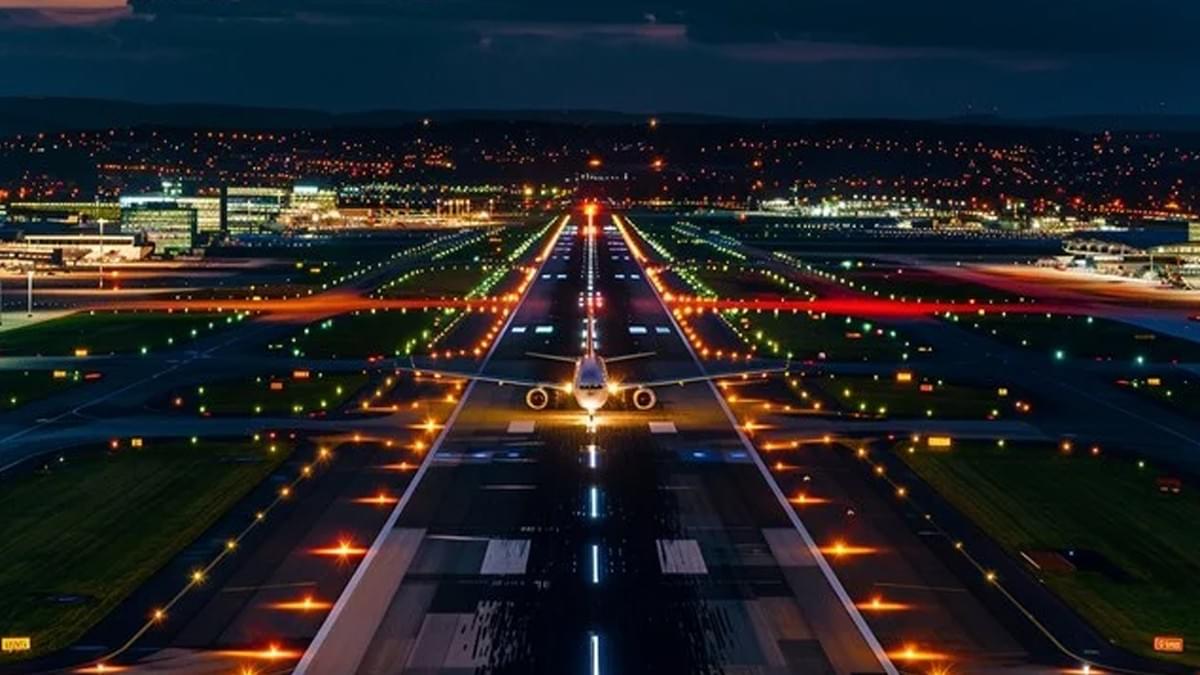
Cost Considerations for Runway Lights
Runway lights represent a significant investment, with costs varying by type, technology, and airport size:
Initial Costs
- LED Edge Lights: \(500–\)1,200 per fixture (higher for ruggedized models).
- Centerline Lights: \(800–\)1,500 each (due to embedded installation).
- Touchdown Zone Lights: \(1,000–\)2,000 per light (specialized optics).
- Control Systems: \(50,000–\)200,000 for dimming and monitoring software.
A medium-sized runway (8,000 feet) with full lighting can cost $1–2 million to install.
Operating Costs
- Electricity: LED runway lights cost \(0.10–\)0.20 per light monthly, vs. \(1–\)2 for incandescents.
- Maintenance: LED systems require \(50–\)100 per light annually, vs. \(200–\)300 for incandescents (due to frequent bulb replacements).
ROI of LED Runway Lights
While LEDs have higher upfront costs, they deliver ROI in 3–5 years through:
- Reduced energy bills (70% savings).
- Lower maintenance costs (fewer replacements).
- Less downtime (critical for airports losing $10,000+ per minute of runway closure).
Innovations in Runway Lights
The runway lights industry is evolving with new technologies to enhance safety and efficiency:
Adaptive Lighting
Adaptive runway lights use cameras and sensors to adjust to real-time conditions:
- Fog Adaptation: Increase intensity and narrow light beams in fog to reduce scatter.
- Glare Reduction: Dim lights automatically whenbright sunlight causes glare, improving visibility for pilots.
- Traffic Responsive: Activate only when aircraft are approaching or on the runway, saving energy at low-traffic times.
Drone-Enhanced Maintenance
Drones equipped with high-resolution cameras and light meters are revolutionizing runway lights maintenance:
- Rapid Inspections: Drones can scan an entire runway’s lights in 30 minutes, compared to 2–3 hours for manual checks.
- Detailed Analysis: Thermal imaging identifies overheating LEDs, while spectrometers verify color accuracy—all without shutting down the runway.
- Cost Savings: Reduce labor costs by 50% and minimize runway closures, a major benefit for busy hubs like Atlanta Hartsfield-Jackson.
Solar-Powered Runway Lights
Solar-integrated runway lights are gaining traction, especially in remote airports with unreliable power grids:
- Off-Grid Capability: Combine solar panels with lithium-ion batteries to operate independently of the electrical grid.
- Low Maintenance: No wiring required, reducing installation and repair costs.
- Sustainability: Lower carbon footprint, aligning with airports’ net-zero goals (e.g., San Francisco International’s 2040 carbon-neutral target).
Li-Fi-Enabled Lights
Li-Fi (light fidelity) uses runway lights to transmit data via light waves, offering:
- High-Speed Communication: Faster than Wi-Fi, allowing real-time transmission of runway conditions, aircraft positions, and weather data to pilots and controllers.
- Security: Light waves don’t penetrate walls, reducing hacking risks compared to radio-based systems.
- Integration: Works with existing LED runway lights, requiring only software upgrades to enable data transmission.
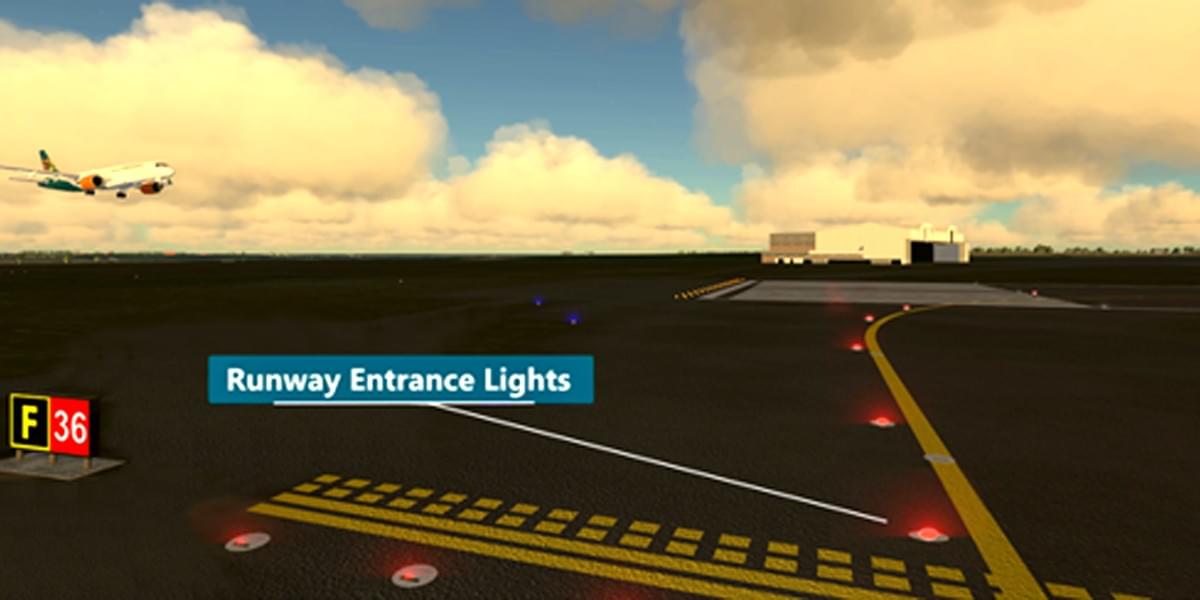
How to Choose the Right Runway Lights for Your Airport?
Selecting the right runway lights depends on your airport’s size, traffic, weather conditions, and regulatory requirements. Here’s a step-by-step guide:
Assess Operational Needs
- Traffic Volume: Busy international airports (e.g., Dubai International) need redundant runway lights systems with backup power to avoid downtime. Smaller regional airports may prioritize cost-effective LED edge lights.
- Weather Challenges: Fog-prone airports (e.g., London Heathrow) require high-intensity, narrow-beam runway lights to cut through mist. Cold-weather airports (e.g., Minneapolis-St. Paul) need heated fixtures to prevent ice buildup.
- Flight Types: Airports serving commercial jets need touchdown zone lights and centerline lights, while those with only general aviation may suffice with basic edge and threshold lights.
Compliance with Regulations
- ICAO vs. Regional Standards: Ensure runway lights meet ICAO Annex 14, then check local variations (e.g., FAA for U.S. airports, EASA for EU).
- Certification Level: If your runway is IFR-certified, verify that lights meet Category I/II/III requirements (e.g., brighter touchdown zone lights for Category II).
Evaluate Technology Options
- LED vs. Solar: Choose LEDs for high-traffic runways needing reliable performance; solar for remote, low-traffic locations.
- Smart vs. Basic Systems: Invest in smart runway lights with sensors and remote control if you need predictive maintenance and adaptive features. Basic systems work for airports with limited budgets.
Calculate Total Cost of Ownership
- Upfront vs. Long-Term Costs: While LEDs cost more initially, their 10-year total cost (purchase + energy + maintenance) is 60% lower than incandescents.
- Lifespan: Factor in replacement cycles—LEDs last 5–10 times longer than incandescents, reducing long-term expenses.
Partner with Reputable Suppliers
Work with suppliers specializing in aviation lighting, as they offer:
- Certified Products: Ensured compliance with ICAO/FAA/EASA standards.
- Installation Expertise: Teams trained in runway safety protocols to minimize installation-related disruptions.
- After-Sales Support: Warranty coverage, maintenance training, and rapid replacement of faulty components.
Case Studies: Runway Lights in Action
Real-world examples demonstrate how the right runway lights enhance safety and efficiency:
Frankfurt Airport: Adaptive Lighting for Fog
Frankfurt Airport, prone to dense fog, upgraded to adaptive runway lights in 2021:
- Sensors detect fog density and automatically narrow light beams to reduce scatter, increasing visibility by 40%.
- Result: 30% fewer fog-related delays, saving airlines an estimated €5 million annually.
- Pilots report improved confidence during low-visibility landings, with 95% rating the new system “excellent.”
Denver International: Solar Runway Lights for Remote Taxiways
Denver International installed solar-powered runway lights on its remote taxiways in 2022:
- Eliminated the need for costly underground wiring across 10 miles of taxiways.
- Withstood -20°F winters and 100°F summers, maintaining 99.9% uptime.
- Reduced carbon emissions by 50 tons annually, supporting Denver’s sustainability goals.
Singapore Changi: Li-Fi Runway Lights for Data Transmission
Changi Airport tested Li-Fi-enabled runway lights in 2023:
- Transmitted real-time runway surface temperature and tire friction data to approaching pilots, reducing hydroplaning risks.
- Data transfer speeds reached 1 Gbps, faster than traditional radio systems.
- Expansion to all runways planned by 2025, positioning Changi as a global leader in aviation tech.
Why Invest in Quality Runway Lights?
The importance of high-quality runway lights cannot be overstated—they directly impact:
Safety
- Prevent runway incursions and excursions, which cause 25% of aviation accidents.
- Enable safe operations in 90% of weather conditions, reducing cancellations and diversions.
Efficiency
- Reduce delays by ensuring consistent visibility, saving airlines $15–20 billion annually worldwide.
- Lower maintenance costs with durable LEDs, freeing up funds for other airport improvements.
Compliance
- Avoid regulatory fines (up to $100,000 per violation in the U.S.) for non-compliant lights.
- Maintain certification for IFR operations, critical for attracting commercial airlines.
Reputation
- Airports with reliable runway lights earn higher pilot satisfaction ratings, improving their standing as preferred hubs.
- Passengers benefit from fewer delays, enhancing brand loyalty.
Our Runway Lights Solutions
Whether you’re upgrading an existing system or building a new runway, we offer tailored runway lights solutions to meet your needs:
Custom Design
Our team conducts a thorough assessment of your airport’s conditions (weather, traffic, regulations) to design a runway lights system that optimizes safety and efficiency. We’ll recommend the right mix of edge lights, centerline lights, and specialty lights (e.g., touchdown zone) for your operations.
Installation & Calibration
Our certified technicians install runway lights with minimal disruption, using advanced tools to ensure precise placement and alignment. We calibrate each light to meet ICAO/FAA/EASA standards, providing certification documentation for regulatory compliance.
Maintenance & Support
We offer comprehensive maintenance packages, including:
- Weekly drone inspections to catch issues early.
- 24/7 technical support for emergency repairs.
- LED replacement programs to prevent unexpected failures.
Upgrade Services
Ready to modernize? We help transition from incandescent to LED runway lights, integrate smart sensors, or add adaptive lighting—all while keeping your runway operational.
Contact Us for Runway Lights Expertise
Don’t compromise on runway safety. Contact us today to discuss your runway lights needs:
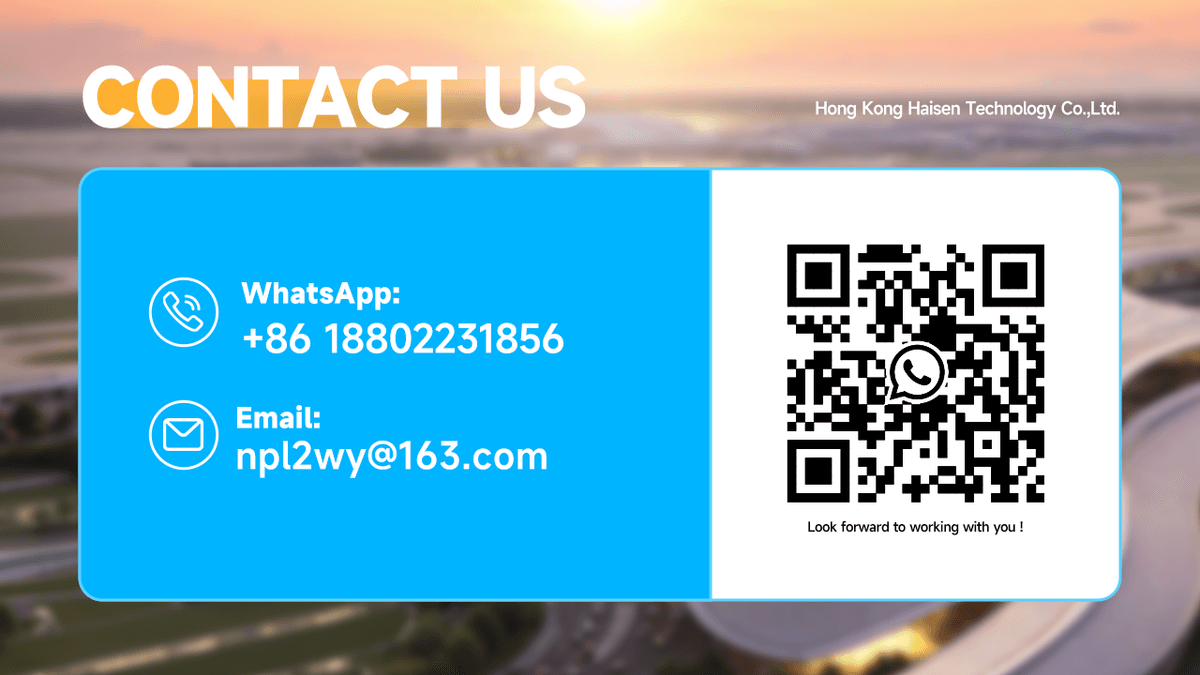
We’ll schedule a free on-site assessment and provide a detailed proposal, including cost estimates and ROI projections. Trust us to deliver runway lights that keep your operations safe, efficient, and compliant—day or night, rain or shine.
Runway lights are the backbone of safe aviation, turning darkness and low visibility into manageable conditions for pilots worldwide. From humble incandescent bulbs to smart, adaptive LED systems, their evolution mirrors the aviation industry’s commitment to safety and innovation. As technology advances, runway lights will continue to play a pivotal role in enabling global air travel—guiding aircraft home safely, one illuminated path at a time. Whether you’re an airport operator, pilot, or aviation enthusiast, understanding runway lights is key to appreciating the precision and care that goes into every flight.
